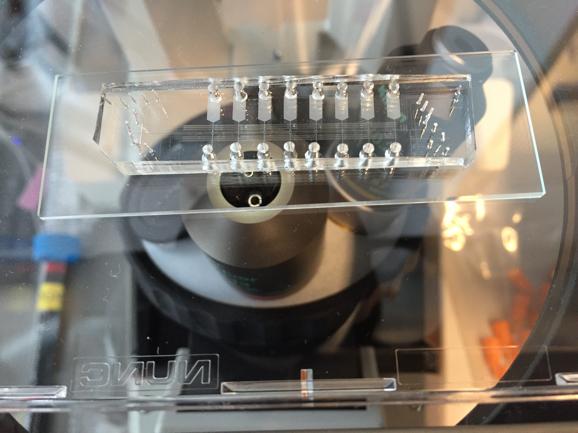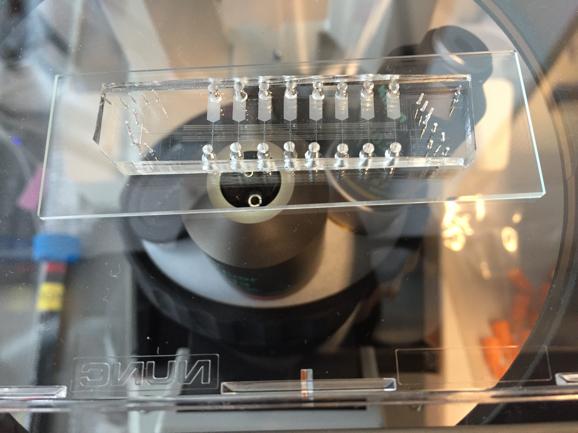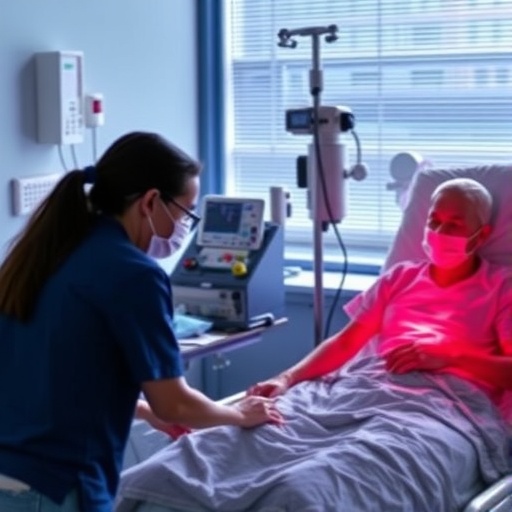
Credit: Alina Isakova/EPFL
Scientists at EPFL have developed a technique that can be a game-changer for genetics by making the characterization of DNA-binding proteins much faster, more accurate, and efficient.
Genes hold the DNA code for producing all the proteins of the cell. To begin this process, genes must first be transcribed from DNA into RNA. This requires a huge family of DNA-binding proteins called transcription factors, which, given their importance in gene expression, are of enormous interest to biologists today. However, because of their sheer number, their ability to combine into different pairs, and the technical difficulty to study their DNA-binding properties in the lab, we still know very little about many transcription factors despite extensive efforts. Now, EPFL scientists have developed a microfluidics-based technique that can greatly speed up the process with a minimum of materials needed, and that can be extended to other molecules and research e.g. analyzing protein-RNA interactions. Publishing in Nature Methods, the researchers have already used the technique to determine the DNA binding properties of over 60 transcription factors including nine new ones.
Transcription factors
Mammals — including humans — have between 1300-2000 transcription factors, many of which combine with others into "heterodimers" in order to bind genes and induce their transcription into RNA. Since one transcription factor can pair up with different ones depending on the cell type in which they are active, the number of possible combinations can be very high.
But it is not enough to just know the identity of transcription factors and which of them pair up; we also need to understand their DNA-binding properties such as their affinity and specificity for DNA – and this also includes heterodimers. This is key if we are to ever exploit transcription factors for biotechnological or pharmaceutical purposes in the future. But it is also very difficult to do experimentally, since it requires relatively large amounts of hard-to-make transcription factors.
In short, profiling transcription factors is a daunting and very complex task. There are several databases that list DNA binding properties, but in total they cover only around 500 single transcription factors, and only a fraction of heterodimers, which are estimated to range between 3000 and 25,000. Understandably, progress in this field is slow, and the available profiles in these databases tend to have only medicocre quantitative value in terms of predicting target genes for these transcription factors.
A microfluidics approach
The lab of Bart Deplancke at EPFL's Institute of Biotechnology has now invented a new technique called SMiLE-seq, which can greatly speed up the process with only tiny amounts of transcription factors needed. The technique makes use of microfluidics, which is the science of controlling tiny amounts of liquids in equally tiny spaces. Microfluidics is fast-becoming an area of excellence at EPFL, bringing together a number of different fields and disciplines.
SMiLE-seq works by attaching small amounts of the transcription factor (or factors when probing heterodimers) in a microfluidic device — this is a chip with micrometer-size channels that allow liquid to flow through. Once the transcription factors are attached to the chip's surface, a large library of random DNA is gently pumped into the chip and flows over them. This allows the transcription factors to recognize their corresponding DNA sequences. Thereafter, the transcription factor-DNA complex is physically trapped by dropping down a microfluidically steered button, while the DNA that is not bound is simply washed away.
Next, the bound DNA is taken off the device and prepared for sequencing to identify which part of it got caught by the transcription factors. This information is fed into specialized software that allows researchers to work out the DNA-binding properties of the transcription factors or heterodimers. In turn, this helps to better predict their in vivo DNA-binding profiles.
The use of microfluidics in SMiLE-seq offers three main advantages: First, it cuts down on the amount of transcription factors needed for this type of experiment, as it only needs picograms of them. Second, it speeds up the process considerably, from days to less than an hour. And finally, SMiLE-seq is not limited by neither the length of the DNA target sequence, nor is it biased toward stronger affinity protein-DNA interactions as current methods can be.
Deplancke's team used SMiLE-seq on 67 full-length human, mouse, and Drosophila transcription factors, successfully analyzing several that were never studied before. In the future, he intends to exploit the technique's versatility into other molecules, such as RNA. His team has filed a patent, and a startup is in the works to take the technological concept of SMiLE-seq into the commercial world.
###
This work involved a collaboration of EPFL's Institute of Bionegineering with its Swiss Institute of Experimental Cancer Research (EPFL-ISREC), Global Health Institute (EPFL-GHI) and the Swiss Institute of Bionformatics. It was funded by the Swiss National Science Foundation, SystemsX.ch, and EPFL.
Reference
Alina Isakova, Romain Groux, Michael Imbeault, Pernille Rainer, Daniel Alpern, Riccardo Dainese, Giovanna Ambrosini, Didier Trono, Philipp Bucher, Bart Deplancke. SMiLE -seq identifies binding motifs of single and dimeric transcription factors. Nature Methods 16 January 2017. DOI: 10.1038/nmeth.4143
Media Contact
Nik Papageorgiou
[email protected]
41-216-932-105
@EPFL_en
http://www.epfl.ch/index.en.html
############
Story Source: Materials provided by Scienmag





